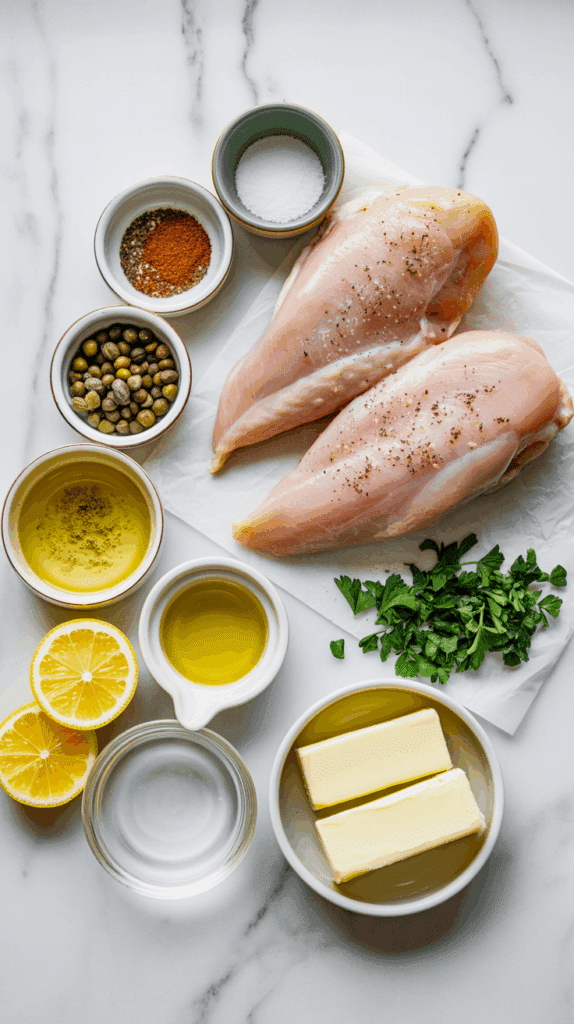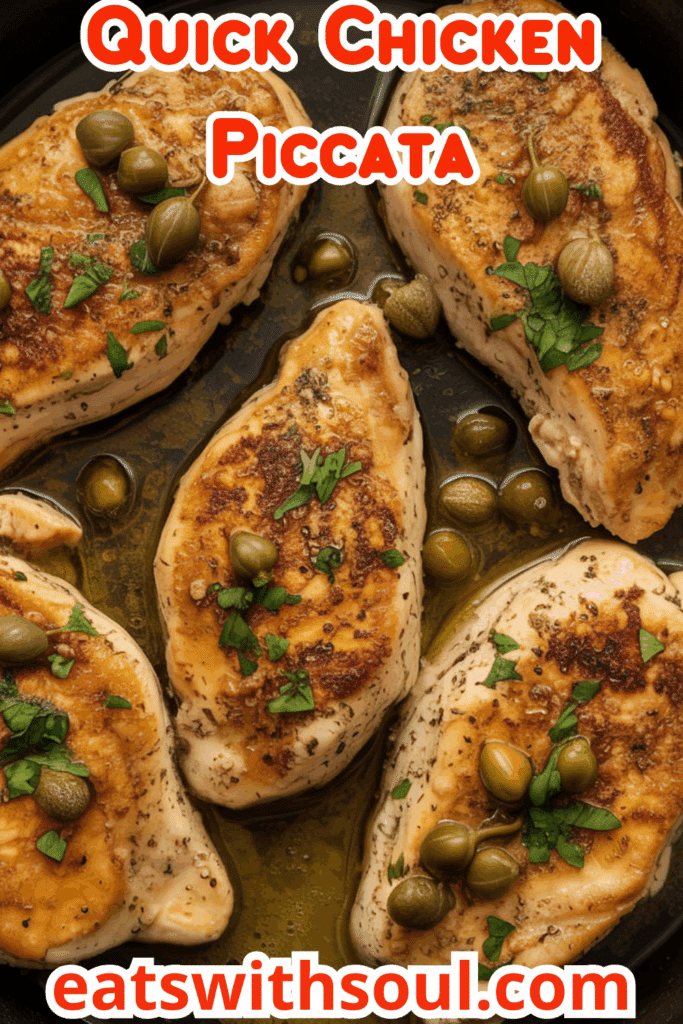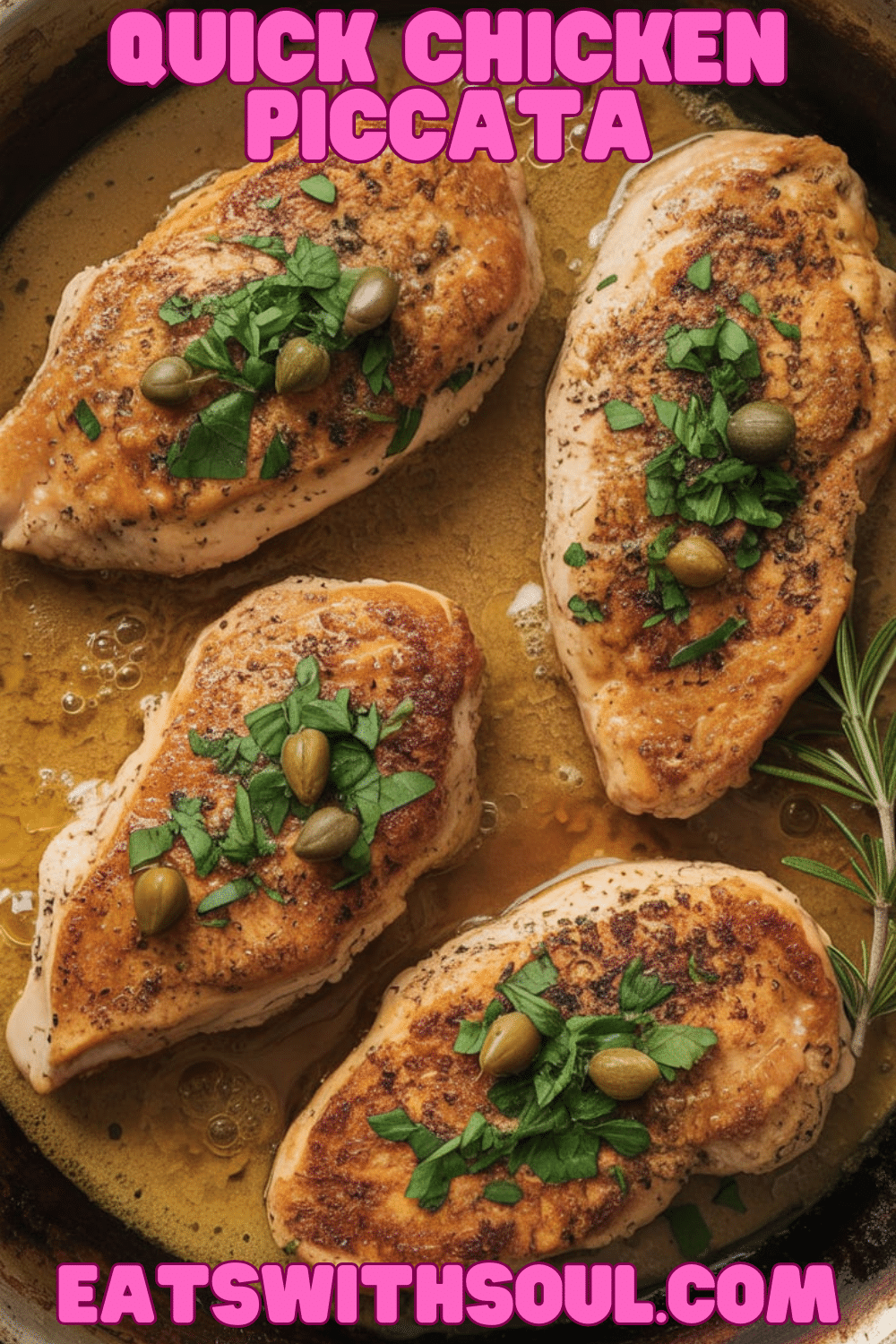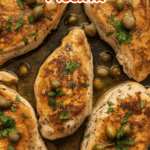Introduction & Inspiration
If you’re looking for a dish that’s impressively elegant, bursting with bright, zesty flavor, yet surprisingly quick and easy to make, then this Quick Chicken Piccata is an absolute must-try! Imagine tender, thinly pounded chicken breast halves, lightly dredged in flour and pan-fried to a beautiful golden brown. They’re then bathed in a classic, vibrant pan sauce made with white wine, fresh lemon juice, briny capers, rich butter, and fresh parsley. It’s a taste of Italian-American restaurant sunshine, right in your own kitchen!
My inspiration for this recipe comes from a deep love for those simple yet sophisticated pan-sauce dishes that truly let quality ingredients shine. Chicken Piccata is a timeless classic because that combination of tangy lemon, salty capers, and rich butter is just undeniably delicious, especially with tender chicken. And “quick” is the name of the game here – perfect for a special weeknight treat!
This dish is fantastic for when you want something flavorful and a bit fancy without spending hours over the stove. It’s light, bright, and always feels like a special occasion. It is a perfect recipe for a quick, elegant dinner.
Nostalgic Appeal / Comfort Factor
Chicken Piccata is a beloved staple in many Italian-American restaurants and homes, holding a certain nostalgic charm. It evokes feelings of classic, satisfying meals, often enjoyed with a side of pasta or crusty bread to soak up that incredible sauce. Pan-fried chicken cutlets, in general, have a comforting, familiar appeal.
This recipe, with its bright lemon-butter-caper sauce, taps into that comforting yet sophisticated flavor profile. The tangy, briny notes from the lemon and capers are perfectly balanced by the richness of the butter, creating a sauce that feels both invigorating and deeply satisfying.
It’s a timeless classic that delivers comfort through its simple elegance and bright, satisfying flavors. A perfect comfort food dish with a touch of class.
Homemade Focus
This Quick Chicken Piccata recipe is a wonderful example of creating a restaurant-quality dish entirely from scratch using fundamental cooking techniques. You’re starting by pounding fresh chicken breasts thin – a key step for tenderness and quick cooking. You’ll then lightly dredge them in seasoned flour and pan-fry them to perfection.
The real homemade magic continues with the creation of the signature pan sauce. Right in the same skillet, utilizing all those flavorful browned bits (fond) left from cooking the chicken, you’ll deglaze with white wine, reduce, then emulsify in cold butter with lemon juice, capers, and fresh parsley. This process of building the sauce from scratch is what makes it truly special.
It celebrates the delicious results achieved through simple, classic homemade techniques, from prepping the chicken to crafting that luscious pan sauce. The homemade taste is incredible.
Flavor Goal
The primary flavor goal is tender, juicy chicken with a light, golden crust, generously coated in a vibrant, tangy, briny, buttery, and herbaceous pan sauce. The chicken itself, seasoned with cayenne, salt, and pepper, should have a subtle warmth.
The sauce is the star: it should be bright and zesty from the fresh lemon juice, with distinct salty, pungent bursts from the capers. The white wine reduction should add depth and a subtle fruitiness. The cold butter, whisked in at the end, creates a smooth, emulsified, rich texture without being heavy. Fresh parsley adds a final touch of herbaceous brightness.
The overall experience should be a harmonious blend of tender chicken and a zesty, savory, buttery sauce that dances on the palate. A perfect balance between flavour and texture.
Ingredient Insights
- Skinless, Boneless Chicken Breast Halves: About 4. Pounding them to an even 1/2-inch thickness is absolutely crucial for quick, even cooking and a tender result.
- Cayenne Pepper, Salt, Ground Black Pepper: For seasoning the chicken. Cayenne adds a very subtle background warmth.
- All-Purpose Flour (for dredging): Provides a light coating that helps the chicken brown nicely and also contributes a tiny bit to thickening the pan sauce.
- Olive Oil: For pan-searing the chicken.
- Capers (Drained): Small, unopened flower buds that are typically brined or salt-packed. They provide a unique tangy, salty, and pungent burst of flavor. Draining them is important. Smashing them lightly in the pan, as suggested, helps release more of their flavor into the sauce.
- White Wine (Dry): Used to deglaze the skillet (lift flavorful browned bits) and forms the base of the sauce, adding acidity and complexity. Pinot Grigio, Sauvignon Blanc, or an unoaked Chardonnay work well. Chicken broth can substitute if avoiding alcohol.
- Fresh Lemon Juice: Essential for the signature bright, tangy flavor of Piccata. Freshly squeezed is a must!
- Water: Used to adjust the sauce volume slightly.
- Cold Unsalted Butter (Cut into ¼-inch slices): Whisked into the sauce off-heat (or over very low heat) at the end. Using cold butter and adding it gradually while whisking helps create a smooth, stable emulsion (this technique is called “monter au beurre”).
- Fresh Italian Parsley (Chopped): Adds fresh, herbaceous flavor and color stirred in at the end. Flat-leaf parsley is typically used.
Essential Equipment
- Meat Mallet or Tenderizer: For pounding the chicken breasts thin.
- Heavy Plastic Wrap or Large Ziploc Bags: To place chicken between while pounding.
- Shallow Dish or Plate: For the flour for dredging.
- Large Skillet (Heavy-Bottomed Stainless Steel or Cast Iron Recommended): Essential for getting a good sear on the chicken and for building a flavorful pan sauce.
- Tongs or Spatula: For handling and flipping the chicken.
- Plate: To set aside cooked chicken.
- Wooden Spoon: For scraping up browned bits when deglazing.
- Whisk (Optional but helpful): For emulsifying the butter into the sauce.
- Knife & Cutting Board: For pounding/prepping chicken (if needed), mincing garlic (if adding as variation), chopping parsley, juicing lemon.
- Measuring Cups & Spoons:
Ingredients
(Original recipe yields 4 servings)
Chicken:
- ▢ 4 skinless, boneless chicken breast halves (approx. 6-8 oz each)
- ▢ Cayenne pepper to taste (start with a pinch or 1/8 tsp)
- ▢ Salt and ground black pepper to taste
- ▢ Approx. 1/2 cup all-purpose flour (for dredging)
- ▢ 2 tablespoons olive oil
Lemon-Butter Caper Sauce:
- ▢ 1 tablespoon capers, drained
- ▢ ½ cup dry white wine (or chicken broth)
- ▢ ¼ cup fresh lemon juice
- ▢ ¼ cup water
- ▢ 3 tablespoons cold unsalted butter, cut into ¼-inch slices
- ▢ 2 tablespoons chopped fresh Italian parsley

Step-by-Step Instructions
1. Prepare the Chicken:
- Place one chicken breast half at a time between two sheets of heavy plastic wrap or inside a large Ziploc bag on a solid, level surface.
- Using the smooth side of a meat mallet or tenderizer, firmly pound the chicken breasts until they are an even 1/2-inch thickness. Pounding not only tenderizes but also ensures quick and even cooking.
- Pat the pounded chicken breasts dry with paper towels. Season both sides generously with cayenne pepper (to taste), salt, and ground black pepper.
- Place the all-purpose flour in a shallow dish. Lightly dredge each seasoned chicken breast in the flour, ensuring a thin, even coating. Gently shake off any excess flour.
2. Sear the Chicken:
- Heat the olive oil in a large, heavy skillet over medium-high heat until the oil is shimmering.
- Carefully place the floured chicken breasts in the hot skillet (do not overcrowd; cook in batches if necessary).
- Reduce the heat to medium. Cook for about 5 minutes per side, or until the chicken is nicely golden brown on both sides and cooked through (internal temperature should reach 165°F/74°C).
- Transfer the cooked chicken to a plate and set aside (tent loosely with foil to keep warm if desired).
3. Start the Pan Sauce:
- In the same skillet used for the chicken (do not wipe it out!), add the drained capers to the reserved oil and pan drippings over medium heat.
- Cook the capers for about 30 seconds, smashing them lightly with the back of a spoon as they warm to help release their brine and flavor.
- Pour the white wine into the skillet. Bring it to a boil while scraping the browned bits (fond) from the bottom of the pan with a wooden spoon – these bits are packed with flavor!
- Let the wine boil and cook until it has reduced by about half, which should take approximately 2 minutes.
4. Finish the Lemon-Butter Caper Sauce:
- Stir the fresh lemon juice and water into the reduced wine mixture in the skillet. Bring back to a gentle simmer.
- Reduce the heat to very low (or remove from heat briefly). Add the cold, sliced unsalted butter, one or two pieces at a time, whisking or swirling the pan constantly until the butter melts and emulsifies into the sauce, creating a smooth, slightly thickened consistency. Continue adding butter pieces until all are incorporated.
- Stir the chopped fresh Italian parsley into the sauce. Taste and adjust seasoning with salt and pepper if needed.
5. Combine Chicken with Sauce and Serve:
- Return the cooked chicken breasts (and any accumulated juices from the plate) to the skillet with the pan sauce.
- Let the chicken cook gently in the sauce for just 1 to 2 minutes, spooning some sauce over the top, until heated through.
- Serve the Chicken Piccata immediately, with generous spoonfuls of the lemon-butter caper sauce spooned over each chicken breast. Enjoy!

Troubleshooting
- Chicken Tough: Overcooked, or wasn’t pounded thin enough. Pounding is key! Use a meat thermometer (165°F).
- Coating Soggy/Falling Off: Chicken too wet before flouring (pat dry!); flour coating too thick; skillet not hot enough for initial sear. Dredge lightly, shake off excess, sear in hot oil.
- Sauce Too Oily/Broken: Butter added too quickly, or sauce got too hot after butter was added, causing it to separate. Add cold butter gradually off heat or on very low heat, whisking constantly.
- Sauce Too Thin: Wine not reduced enough, or too much water added. Ensure wine reduces by half. Sauce should be emulsified and lightly coat a spoon, not be watery.
- Sauce Too Acidic/Tart: Too much lemon juice for your taste, or wine was very acidic. Balance with a tiny pinch of sugar if absolutely necessary (not traditional), or ensure enough butter emulsifies to mellow it.
- Capers Too Salty: Some brands are saltier. Draining well is important. If very salty, you can give them a very quick rinse and pat dry.
Tips and Variations
- Pound Chicken Evenly: This is crucial for tender results and quick, even cooking.
- Don’t Overcrowd Skillet: Sear chicken in batches if needed to maintain pan temperature for a good crust.
- Cold Butter for Sauce: Adding cold butter, piece by piece, to the warm (not boiling) sauce while whisking helps create a smooth, stable emulsion. This is a classic French technique called “monter au beurre.”
- Fresh Lemon Juice is Best: For that bright, authentic Piccata flavor.
- Veal Piccata: Substitute thinly pounded veal cutlets for chicken for the traditional version.
- Add Mushrooms or Artichokes: Sauté sliced mushrooms or add drained, quartered artichoke hearts to the pan before deglazing with wine.
- Different Herbs: While parsley is classic, a touch of fresh thyme or chives could also be nice.
- No Wine? Substitute an equal amount of good quality chicken broth for the white wine. The flavor will be slightly different but still delicious.
Serving and Pairing Suggestions
- Serve Immediately: Best enjoyed hot while the sauce is luscious and the chicken tender.
- Over Pasta: Classically served over angel hair pasta or linguine to soak up the sauce.
- With Rice Pilaf or Orzo: Simple grain sides work beautifully.
- With Mashed Potatoes: Creamy mashed potatoes are also great for the sauce.
- Steamed Vegetables: Asparagus, green beans, or sautéed spinach are lovely accompaniments.
- Crusty Bread: Essential for mopping up every last bit of that amazing sauce!
- Wine Pairing: Pairs wonderfully with crisp, dry white wines like Pinot Grigio, Sauvignon Blanc, or Verdicchio.
Nutritional Information
(Original recipe yields 4 servings. This is an estimate per serving.)
- Calories: 400-550
- Fat: 25-35g
- Saturated Fat: 10-15g (from butter)
- Cholesterol: 150-200mg
- Sodium: 500-800mg+ (depending on capers, added salt)
- Total Carbohydrates: 5-10g
- Dietary Fiber: <1g
- Sugars: 1-3g
- Protein: 40-50g
(Disclaimer: Nutritional information is an estimate and can vary based on specific ingredients, portion sizes, and cooking methods.)
PrintQuick & Classic Chicken Piccata with Lemon-Butter Caper Sauce
Make a delicious and Quick Chicken Piccata! This easy recipe features thinly pounded chicken breasts pan-fried until golden, served with a zesty lemon-butter caper sauce.
Ingredients
(Original recipe yields 4 servings)
Chicken:
- ▢ 4 skinless, boneless chicken breast halves (approx. 6-8 oz each)
- ▢ Cayenne pepper to taste (start with a pinch or 1/8 tsp)
- ▢ Salt and ground black pepper to taste
- ▢ Approx. 1/2 cup all-purpose flour (for dredging)
- ▢ 2 tablespoons olive oil
Lemon-Butter Caper Sauce:
- ▢ 1 tablespoon capers, drained
- ▢ ½ cup dry white wine (or chicken broth)
- ▢ ¼ cup fresh lemon juice
- ▢ ¼ cup water
- ▢ 3 tablespoons cold unsalted butter, cut into ¼-inch slices
- ▢ 2 tablespoons chopped fresh Italian parsley
Instructions
. Prepare the Chicken:
- Place one chicken breast half at a time between two sheets of heavy plastic wrap or inside a large Ziploc bag on a solid, level surface.
- Using the smooth side of a meat mallet or tenderizer, firmly pound the chicken breasts until they are an even 1/2-inch thickness. Pounding not only tenderizes but also ensures quick and even cooking.
- Pat the pounded chicken breasts dry with paper towels. Season both sides generously with cayenne pepper (to taste), salt, and ground black pepper.
- Place the all-purpose flour in a shallow dish. Lightly dredge each seasoned chicken breast in the flour, ensuring a thin, even coating. Gently shake off any excess flour.
2. Sear the Chicken:
- Heat the olive oil in a large, heavy skillet over medium-high heat until the oil is shimmering.
- Carefully place the floured chicken breasts in the hot skillet (do not overcrowd; cook in batches if necessary).
- Reduce the heat to medium. Cook for about 5 minutes per side, or until the chicken is nicely golden brown on both sides and cooked through (internal temperature should reach 165°F/74°C).
- Transfer the cooked chicken to a plate and set aside (tent loosely with foil to keep warm if desired).
3. Start the Pan Sauce:
- In the same skillet used for the chicken (do not wipe it out!), add the drained capers to the reserved oil and pan drippings over medium heat.
- Cook the capers for about 30 seconds, smashing them lightly with the back of a spoon as they warm to help release their brine and flavor.
- Pour the white wine into the skillet. Bring it to a boil while scraping the browned bits (fond) from the bottom of the pan with a wooden spoon – these bits are packed with flavor!
- Let the wine boil and cook until it has reduced by about half, which should take approximately 2 minutes.
4. Finish the Lemon-Butter Caper Sauce:
- Stir the fresh lemon juice and water into the reduced wine mixture in the skillet. Bring back to a gentle simmer.
- Reduce the heat to very low (or remove from heat briefly). Add the cold, sliced unsalted butter, one or two pieces at a time, whisking or swirling the pan constantly until the butter melts and emulsifies into the sauce, creating a smooth, slightly thickened consistency. Continue adding butter pieces until all are incorporated.
- Stir the chopped fresh Italian parsley into the sauce. Taste and adjust seasoning with salt and pepper if needed.
5. Combine Chicken with Sauce and Serve:
- Return the cooked chicken breasts (and any accumulated juices from the plate) to the skillet with the pan sauce.
- Let the chicken cook gently in the sauce for just 1 to 2 minutes, spooning some sauce over the top, until heated through.
- Serve the Chicken Piccata immediately, with generous spoonfuls of the lemon-butter caper sauce spooned over each chicken breast. Enjoy!
Recipe Summary and Q&A
Summary: This Quick Chicken Piccata involves pounding boneless, skinless chicken breast halves thin, seasoning them with cayenne, salt, and pepper, then lightly dredging in flour. The chicken is pan-seared in olive oil until golden brown and cooked through. A pan sauce is then made in the same skillet by briefly cooking drained capers, deglazing with white wine, reducing the wine, and then stirring in lemon juice, water, and pieces of cold unsalted butter to create an emulsified sauce. Fresh chopped parsley is stirred in at the end, and the cooked chicken is returned to the pan to heat through before being served with the sauce spooned over.
Q&A:
- Q: What are capers and do I have to use them?
- A: Capers are the unripened flower buds of a Mediterranean bush, typically pickled in brine or salt-packed. They have a distinct tangy, salty, and slightly floral/pungent flavor that is characteristic of Piccata sauce. While you could omit them, the dish wouldn’t be true Chicken Piccata without their unique flavor.
- Q: Why pound the chicken so thin?
- A: Pounding the chicken to an even 1/2-inch thickness (or even thinner for some preferences) does two important things: it tenderizes the meat by breaking down fibers, and it ensures the chicken cooks very quickly and evenly without drying out.
- Q: My sauce looks separated or oily. How can I fix it?
- A: This usually means the emulsion broke, likely because the butter was added too quickly or the sauce got too hot after the butter was incorporated. Try removing the pan from the heat and whisking vigorously. Sometimes adding another tiny piece of cold butter while whisking can help bring it back together. Ensure you add cold butter gradually to warm (not simmering or boiling) liquid off heat or on very low heat.
- Q: Can I use chicken broth instead of white wine?
- A: Yes, you can substitute an equal amount of chicken broth for the white wine. The wine adds a specific acidity and depth of flavor, but broth will still make a delicious sauce. You might want to add an extra squeeze of lemon juice if using only broth to ensure enough brightness.

